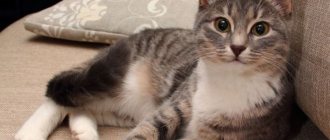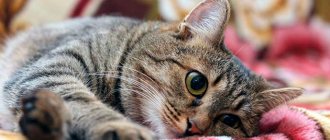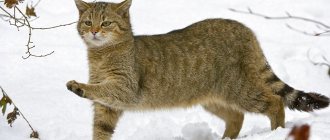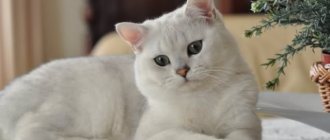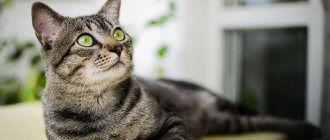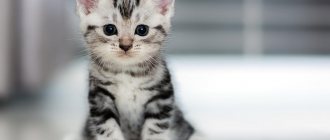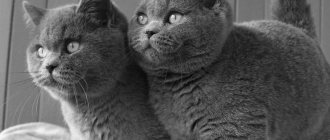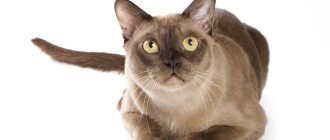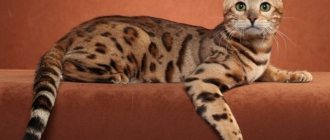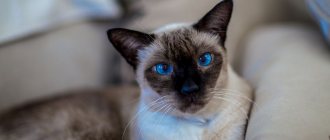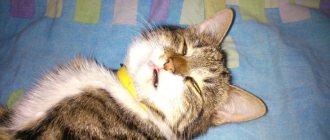The European Shorthair (Celtic) is a breed of domestic cat, developed through selective breeding in the middle of the last century. These are graceful creatures that combine excellent hunting qualities, friendliness and high intelligence. Compared to exotic breeds, Europeans look quite simple, but this is exactly the image that comes to mind when talking about domestic cats.
History of the origin of the European Shorthair
global $ads_google;
//data-ad-slot=”2475549904″ $ads_google = empty($ads_google) ? false : true; ?> if ($ads_google == false) {?> $ads_google = true; ?> } ?> How harmonious and beautiful it is to take a gift from nature and, with the help of some intervention, improve it, turning it into a wonderful purring creature. In these lines you can see a brief history of the origin of the European shorthair cat, whose ancestors lived freely in most of the northern territories of Europe.
The genes of aboriginal cats turned out to be strong and were easily passed on from generation to generation, which resulted in a specific type of appearance and temperament.
Breeders paid attention to the animal, but since the approaches were different, the appearance of the bred breeds was somewhat different from each other, and the names were different.
So there is no special legend in the origin of seals: the whole of Europe can safely be considered the animal’s homeland. The first time a European (Celtic) cat appeared at an exhibition was in 1938, but a similar cat was registered as a representative of the breed only in 1948, and then as a variety of the British one. The new breed received official status only in 1981.
Interesting Facts
The development of a new breed began almost simultaneously in Norway, Denmark and Sweden. A little later, England, Germany, and France joined this process.
And if the first three got a Celtic or Swedish domestic cat (in Sweden), then the second three called their creation a European (or British) shorthair cat. France went even further and gave its pets the name “chartreuse”.
Later, the United States got involved and developed its own breed, calling it the American Shorthair cat.
The confusion over the names was ended in 1982, when the breed standard was recognized and the name “Celtic” or “European Shorthair” was established.
The breed is not particularly popular among followers of fashionable cats, as it has the most ordinary appearance and independent character, which it will not fail to show to its owner.
But for connoisseurs of simplicity and reliability, these animals are simply irreplaceable.
Description of the European Shorthair cat
Despite some similarities with British cats, obvious differences in the breeds are visible in the cat from a young age. The description of the standard dictates clear characteristics of the appearance of short-haired Europeans, so it is impossible to make a mistake.
The head is of medium size and looks wide and round. The nose looks smooth and straight, the transition from the nose to the forehead is nevertheless definitely noticeable.
The ears are medium in size, widely spaced from each other and arranged vertically, and the width and height of the ears are the same. Sometimes there are tassels at the ends.
The eyes are also widely spaced from each other and somewhat slanted. A feature of the eye color is that the color of the iris matches the color of the fur coat. If the fur is red in color, then the eyes will be bright amber; gray cats have gray or blue eyes, but black cats will always have magical green shades of the iris.
The limbs of the Celts are powerful, the paws are round.
Closer to the base of medium length, the tail is wide and narrowed at the end.
The cat's fur is shiny and thick. Despite the short pile, this breed will not be found on the list of hypoallergenic.
Various colors are allowed, with the exception of chocolate, lilac, fawn and acromelanic varieties. All other colors can be found among happy owners of representatives of this breed.
Dimensions and weight of the European cat
global $ads_google;
//data-ad-slot=”2475549904″ $ads_google = empty($ads_google) ? false : true; ?> if ($ads_google == false) {?> $ads_google = true; ?> } ?> It is amazing how small kittens at the age of several months grow into quite large and muscular animals, with grace, strength, flexibility and natural agility. The impression of impressiveness is given by developed muscles, although in fact the cats are more of a medium size than a large one.
According to the tradition of natural data, females are inferior to males in size: their length, weight and height are always somewhat less than those of males. A European cat weighs approximately 2.5-5 kg, and an adult cat weighs 3-8 kg.
| Age | Female | Male |
| newborn | 65-140 gr | 70-150 gr |
| 1 month | 260-620 gr | 540-750 gr |
| 2 months | 450-915 g | 900-1500 gr |
| 3 months | 1-1.4 kg | 1.4-2.5 kg |
| 4 months | 1.3-2.5 kg | 1.5-3.6 kg |
| 5 months | 2.0-2.8 kg | 2-4.1 kg |
| 6 months | 2.1-3.3 kg | 2.3-4.8 kg |
| 8 months | 2.2-3.9 kg | 2.4-5.2 kg |
| 10 months | 2.3-4.1 kg | 2.5-5.7 kg |
| 1 year | 2.4-4.7 kg | 3.1-6.6 kg |
| 2 years | 2.5-5.0kg | 3.3-8.0 kg |
Nutrition
You can feed your cat both natural food and prepared food. Representatives of this breed are unpretentious and do not require specific nutrition. Celts are not prone to overeating and obesity.
If the choice is made on industrially produced food, then it is easy to choose for your pet what is suitable for its age and weight, and also takes into account its individual characteristics. High-quality food contains all the necessary nutrients, vitamins and minerals.
It is best to feed your cat dry food, periodically introducing a variety of canned food.
A natural diet should consist of 80% protein foods. These are lean meats, meat by-products, eggs, dairy products, and sometimes you can pamper your pet with fish or seafood. Whole milk should not be given to an animal, since its digestive tract is not capable of assimilating it. However, it is quite possible to feed it with cottage cheese, yogurt, fermented baked milk. Vegetables (boiled) and cereals are also needed in small quantities.
With a natural diet, experts recommend giving courses of vitamin and mineral supplements to be sure that the pet’s body is provided with all the necessary substances.
There is no need to feed your cat food from your table; you need to cook for it without adding salt or spices. You should also make sure that the animal always has a bowl of clean and fresh water. It needs to be changed quite often, since the cat will no longer drink if it has been left for a while.
Habits and character of the European Shorthair breed
It’s not without reason that European Shorthairs are so revered and loved, judging by the reviews of owners in different countries: the cat’s disposition is not only calm, but also very affectionate.
At first, the cat even seems timid when it is first brought into the house. This is not the kind of fighter who throws his chest at an embrasure - first the pet carefully examines everything, and only then decides whether the owners of this house deserve trust.
When a Celt settles in and gets used to its owner, then all the features and facets of the cat’s character are already demonstrated. The habits of the animal are pleasant and understandable to adults and children: short-haired cats love to actively play and have fun, and do not particularly expect attention, since they themselves have a good time. This is a definite plus for the breed for those people who spend a lot of time outside the home.
The breed's character is exceptionally kind, so cute cats will not be a threat to small children. In extreme cases, if the pet itself gets scared or angry, then it will not bite or scratch, but will simply express its emotions by hissing.
A high level of intelligence can easily be attributed to the sociability and simultaneous unobtrusiveness of cats of this breed. With due diligence of the owners, it is possible to engage in training along with raising a cat with excellent results.
Don’t worry if suddenly after work you have absolutely no energy or desire to communicate - the pet will understand this and wait, minding its own business.
Character
The European Shorthair cat is moderately independent and values personal space. It is unlikely that you will be able to force communication on her. The cat is attached to the owner, but will not clearly advertise its feelings, constantly caress or accompany you around the apartment, wagging its tail. He accepts affection only when he wants and only from family members whom he trusts. He will treat visits from guests calmly, does not recognize strangers, but will not show aggression either; most likely, he will prefer to retire to a secluded, calm place.
Celtic kittens are very active and require increased attention; they get bored when alone and often find entertainment that the owner may not like. As cats grow up, they become calmer and more reasonable, do not require much attention and are quietly left alone for quite a long period. At the same time, they do not lose their curiosity and are sometimes playful, like kittens. These cats get along well with children, but this does not manifest themselves in joint games; the European cat will prefer to maintain a safe distance.
Celtic cats have a strong nervous system and a high level of intelligence. They get along well with other cats and dogs, they are sociable and non-conflicting. But cohabitation with small animals is dangerous; rodents, birds or fish will always remain potential prey for them.
Care and feeding of the European shorthair cat
The great news is that Celtic cats do not require special care. Caring for the breed is simple; it is enough to follow a number of standard procedures.
Once a month, the kitty needs to have its claws trimmed, and once a week or two, the ears need to be examined - if they look dirty, they need to be cleaned with a damp cotton pad. The eyes are washed as they become dirty.
The cat's fur is short, so the breed does not need a haircut, and the kitty can be bathed with cat shampoo about once every six months. During this time, a bath can easily be replaced by combing.
Keeping a European Shorthair requires proper nutrition. The food can be natural or ready-made; the breeder himself chooses what his pet’s diet will be.
You cannot feed your cat milk, raw fish, salty, spicy or sweet foods, but the menu should contain at least 30% and up to 70% meat.
In general, cats are unpretentious in nutrition, and feel great thanks to the high protein content and low fat and carbohydrate content. In addition to meat, the menu should include cereals, vegetables and dairy products.
Feeding small kittens is more fractional: their daily diet is divided into 4-5 servings.
Choosing and caring for a kitten
When choosing a kitten of the European breed, you should not take risks and buy it on the market. It is best to choose it in a special nursery. A representative of this breed must have all the relevant documents.
European kittens need the same care as adult cats. They are vaccinated already at the eighth week, if the mother cat has not been vaccinated. If the cat has been vaccinated, the kitten can be vaccinated at 12 weeks. It is recommended to avoid vaccinations while changing teeth. It begins at four months and lasts until seven.
Proper animal care, balanced nutrition and timely vaccinations will help the cat grow healthy and active and delight its owners.
Celtic cat health
The most wonderful information about the health of the European Shorthair should be considered the absence of genetic diseases. Simple cat diseases can be avoided if vaccinations are not skipped. Although the breed is healthy, no one has canceled vaccinations as an immune defense! This applies even to those cats that do not leave the house: people bring viruses and bacteria from the street on their clothes and shoes, this is quite enough to create a threat to the cat’s health.
Despite the vaccinations, there are a number of diseases that can undermine a pet’s health and even cause a high temperature. In this case, you should not ignore the advice of veterinarians.
Before the age of one year, pets of this breed that will not take part in breeding should be castrated or sterilized. It is worth finding out the difference between these operations and making a choice.
When a cat comes into third heat, you can send your pet for mating. Mating is arranged in the first two days of estrus with an experienced cat partner.
global $ads_google; //data-ad-slot=”2475549904″ $ads_google = empty($ads_google) ? false : true; ?> if ($ads_google == false) {?>
$ads_google = true; ?> } ?>
Pregnancy proceeds smoothly for an average of 65 days, and childbirth usually ends with the appearance of healthy offspring.
The life expectancy of pets is good and ranges from 15 to 17 years.
Features of behavior
“Europeans” behave quite modestly; more often this behavior is observed when a stranger appears in the house. On the contrary, the pet behaves affectionately and friendly with its owner. Owners of European cats note that the pet is sanguine by nature - he loves to have fun with the owner at any time, but at the same time they are unobtrusive and do not require undue attention.
Advantages and disadvantages of the character of the European smooth-haired cat
The pet is indifferent to the guests of its owners; it does not ask to be held in their arms to be petted. This cat communicates with children as equals, hiding arrogance and aggression. Many cat owners notice the intellectual abilities of Celts and believe that they understand human language.
Despite its positive character, the Eastern European cat will not tolerate another pet in the house. As the leader of the home, this cat agrees to recognize only a person, well, or herself. Therefore, it is impossible for a Celtic cat to live together in the same house with other animals.
Buy a European shorthair kitten
Searches for officially registered nurseries in Russia will lead nowhere, and although the practice of turning to sites like Avito is risky, many have to turn to private breeders through them. If you have a strong desire to buy a purebred European Shorthair cat, then it makes sense to look for foreign nurseries and discuss options for purchasing a purebred kitten.
Abroad, a cat of this breed costs proportionately more: a baby will cost 30,000-40,000 rubles.
In Russia, private breeders do not charge too high a price, despite the fact that it is not easy to get a purebred cat for breeding. The cost of kotofeev is approximately 15,000 rubles.
Nicknames for European cats
The acquisition of a young European always becomes a joyful event for the whole family. The time of first delight passes and the question arises: what name should be given to a furry boy or girl of this marvelous breed?
There are a number of tips on how to choose a name for a kitten:
· pay attention to the euphony of the nickname, the presence of hissing sounds in the name;
· The gender of the animal plays a role, but there are nicknames that suit any animal. Boys are given more serious and masculine, even brutal names, while girls are called more elegantly and gracefully;
· The nickname should not be too long.
There are a number of great names that would suit your family pet!
| Girl | Boy | ||
| Violet Fronda Ivy Jozefa Tella Ulita Wax Zhuzha Ulla Dolka Yula Ishka Kerry Rady Beni | Baileys Naomi Tasha Feri Alura Enya Mouse Malvina Aurora Rusya Brada Isabella Marfa Jay Panther | Black Fonya Frank Archik Rain Veer Spark Achi Bert Guidon Star Sherlock Norman Timmy Barry Winston | Archibald Chappie Spark Hector Kazbek Polkan Irwin Tikhon Shah Schumacher Smiley Chang Khariton Marquis Sibelius |
Health of European cats
Tricolor cat: are there males?
The European Shorthair is in excellent health and has no hereditary diseases. This has a definite advantage when choosing a pet.
Diseases
The Celtic European cat has high immunity. Increased endurance and agility allow the cat to withstand heavy loads and long runs. To keep the cat healthy, owners must only follow some recommendations:
- vaccinate the animal on time;
- undergo examinations by a veterinarian;
- deworm regularly;
- clean ears and teeth;
- comb out.
How long do they live?
This breed is long-lived. If they are kept outside, they live up to 15 years, and if kept at home - up to 25. This fact is due to the fact that pets are less exposed to stress, they are less likely to die from external influences.
An adult “European” can live up to 25 years
Conclusions about the breed
The European Shorthair cat, once in the house, immediately falls into the hearts of the owners. This can be easily explained by the pet’s personal data and the characteristics of its breed:
- genetic health and good immunity;
- a good pregnancy and easy childbirth;
- not picky about care: you won’t need to spend a lot of time getting your pet in order;
- unpretentiousness in food;
- the animal’s sociability does not interfere with busy owners; the cat is always interested in spending time with someone and with himself;
- a kind and gentle disposition is characteristic of this breed.
Despite the difficulties in acquiring and breeding a beloved beauty, more and more people are giving their liking to Europeans and finding ways to get the desired breed into their home.
Diet
It is recommended to feed European cats with industrial dry and wet food. The higher the grade of feed, the better its quality. It's better not to buy economy class.
Be sure to read:
Russian Blue cat: description of the breed and character, advantages of the breed
Europeans can buy special grass. It helps get rid of hairballs that a cat swallows while licking itself.
Important! You cannot feed your animal meat and fish without heat treatment.
Appearance
The Celtic breed has pronounced sexual dimorphism. Depending on the gender, the weight of cats ranges from 4 to 8 kg.
According to the approved standard, purebred representatives have:
- wide-set ears, rounded at the tips (tassels are allowed);
- large, rounded head with developed cheeks and a strong chin;
- rounded eyes, characterized by uniform color of the iris (amber, green and blue shades, as well as heterochromia, are acceptable);
- a distinct stop, characterized by a slight depression between the eyes;
- flexible body with developed muscles and a rounded chest;
- strong and strong paws, tapering at the base;
- tail of medium length with a rounded narrow tip and a wide base.
The Celts have a short and thick coat, distinguished by the shine and elasticity of the hairs.
Australian mist
British Fold cat breed
Ragdoll cats
The standard allows any colors except:
- chocolate;
- acromelanic (Siamese);
- lilac;
- cinnamon (red-brown).
- faun.
All of the listed colors are a consequence of mixing with other breeds, which is strictly prohibited.
